SS Sonderkommando Sobibor
Lower Ranking Officers
Listed in Alphabetical Order
BARBL, Heinrich
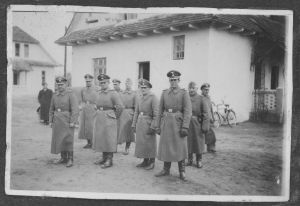
Heinrich Barbl - First Right - Belzec Kommandantur
Born on 3 March 1900 in Sarleinsbach, Austria. He worked at the T4 institution at Hartheim before being sent to the Belzec death camp in Poland where he helped install the gas pipes. He referred to himself as the Hausklemper (plumber) he worked with Erich Fuchs on the installation of gas pipes in the gas chambers in Sobibor.
BAUCH, Ernst
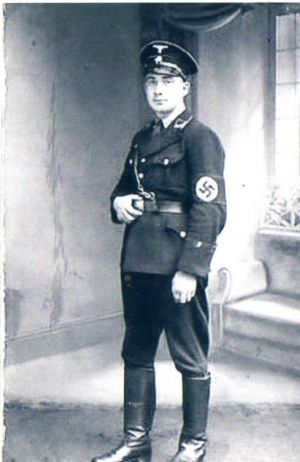
Ernst Bauch - from his personnel file
Born on 30 April 1911 in Grinsdorf. He served in the T4 institution at Grafeneck. He arrived in Sobibor in April 1942. He committed suicide on 4 December 1942 in Berlin. Karl Frenzel attended his funeral in Berlin.
BAUER, Hermann Erich
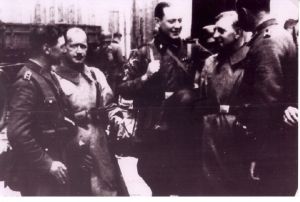
Erich Bauer - Second from left in Italy
Born on 26 March 1900 in Berlin. A former Tram conductor, he also worked as a driver for T4. Bauer went to Sobibor in April 1942 and he was in charge of the gas chambers in Lager III. He described himself as the Gasmeister of Sobibor during his trial. He was also the lorry driver of the camp, and he was responsible for carrying the coffins to Chelm.
In 1946 he worked in Berlin clearing the ruins. Whilst doing this he was spotted on the street by former Sobibor inmates Samuel Lerer and Estera Raab in 1949, who reported him to the Police. On 8 May 1950, at his trial in Berlin-
BECHER, Werner
Born on 26 April 1912 in Annaberg/ Aue. He worked at the T4 institution at Pirna/Sonnenstein as a chauffeur. He served at Sobibor from August until November 1942, where he supervised the sorting barracks in Lager II and he also worked in Lager III.
BECKMANN, Rudolf, Heinrich
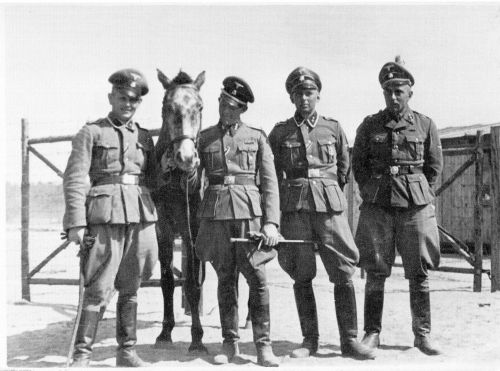
Sobibor, Unknown, Niemann, Beckmann, Rost by the Sorting Barracks
BECKMANN, Rudolf Heinrich. Born on November 21, 1904, in Buer, Kreis Gelsenkirchen, Westfalen. His father was Johann Beckmann, who was a miner by profession, who passed away during 1917. His mother was Antoinette Beckmann, formerly Eltrop. Rudolf Beckmann was one of six children, three brothers and two sisters.
He was a qualified farmer by profession, and he ran a farm at Ottmarsbocholt, skills which he used at the T4 Instutions of Grafeneck and Hadamar. He was transferred to the Sobibor death camp in April 1942, where he was in charge of sorting the Jewish victims possessions in Lager II, and he was also in charge of administration matters, based in the Foresters House. It was in the Foresters House that Rudolf Beckmann was killed during the prisoner revolt on October 14, 1943. He was stabbed to death by Chaim Engel and Kapo Szymon Pozyczki, and he was buried at the Cholm Military Cemetery in grave number 402. On his Grabmeldung issued his rank was listed as SS-Unterscharfuhrer, although it is generally accepted that his proper rank was as an SS-Oberscharfuhrer
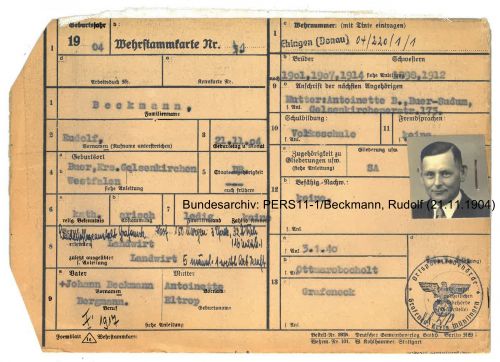
Rudolf Beckmann Identity Card (Bundesarchiv)
BEULICH, Max
Born on 9 March 1903. He was a male nurse at Pirna / Sonnenstein. He served in Sobibor death camp, but no other details known.
BLAUROCK, Emil
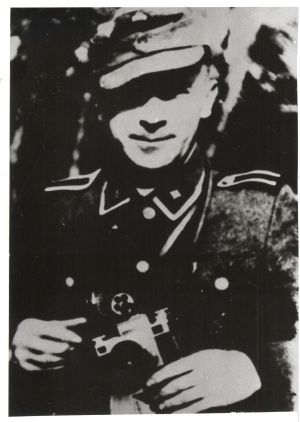
Born on 25 January 1897. He was a male nurse at Pirna/ Sonnenstein. He served in Sobibor death camp. He was detained by the US Army in Bad Aiblingen, Bavaria. He was discharged from internment on 19 April 1946.
BOLENDER, Heinz Kurt
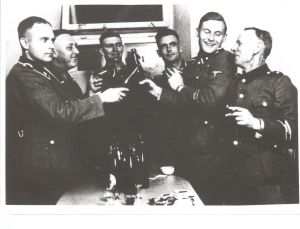
Kurt Bolender second from right
Born on 21 May 1912 in Duisberg. He served at the T4 institutions at Brandenburg, Hadamar, Hartheim and Pirna /Sonnenstein. Bolender arrived in Sobibor on 22 April 1942, along with a group that included Stangl, Frenzel and Gomerski.In Sobibor he served in Lager III, supervising the mass graves.
In July 1942 he was arrested for perjury during his divorce case and was punished by an SS-
He was arrested in May 1961 and he committed suicide before he was due to be sentenced after the first trial of Sobibor personnel in Hagen on 10 October 1966.
BORNER, Gerhard
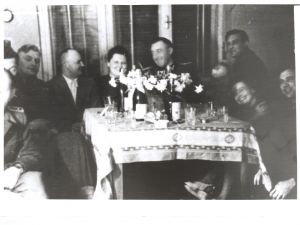
Gerhard Borner First Left in Sobibor
Born on 28 October 1905 in Dresden. He served at the T4 institution at Pirna/ Sonnenstein, as chief of the economics office. He was photographed at Sobibor at the Stangl party. After Sobibor he was posted to Italy. Nothing more is known.
BREDOW, Paul
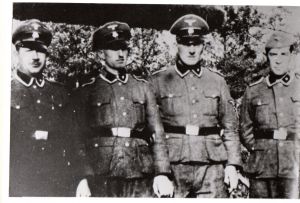
Paul Bredow First Left in Treblinka
Born on 31 October 1903 in Guttland, Danzig District. A male nurse who served at the Grafeneck and Hartheim institutions. He was posted to the Sobibor death camp with Stangl and others. Bredow was in charge of the Lazarett at Sobibor, where he displayed untold cruelty in shooting Jewish prisoners. He served at Sobibor until the spring of 1943, when he was posted to Treblinka death camp, where he was in charge of "Sorting Barracks A," the clothing barracks. After the closure of Treblinka, he went to Trieste in Italy, and after the war he worked together with another former Sobibor staff member, Karl Frenzel in Giessen, as a carpenter until November 1945. In December 1945 he was killed in an accident in Gottingen.
BREE, Max
Born during 1914, in Lubben / Spreewald and he arrived at Sobibor from the Treblinka death camp around June 1943. Due to his relatively late arrival, very little is known about him, other than that he supervised the Ukrainian guards at well as the Jewish workers in the sorting barracks. He was killed during the prisoner revolt on 14 October 1943.
DACHSEL, Arthur
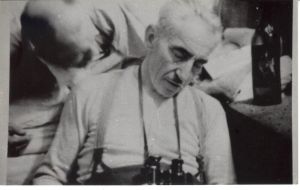
Arthur Dachsel in Italy
Born during 1890, in Bohlen, Riesa. Arthur Dachsel worked at the T4 institution at Pirna/ Sonnenstein, where he incinerated bodies. He served at the Belzec death camp in Poland and in July 1942 he was transferred to the Sobibor death camp, where he supervised the Waldkommando. He was promoted to the rank of Oberwachtmeister in March 1943. He was remembered by Thomas (Toivi) Blatt as one of the least brutal SS men.
DIETZE, Erich
Born on 2 November 1905 and worked at the T4 institution at Pirna/Sonnenstein, as an administrator.He was posted to Sobibor death camp. No more details known.
DUBOIS, Werner
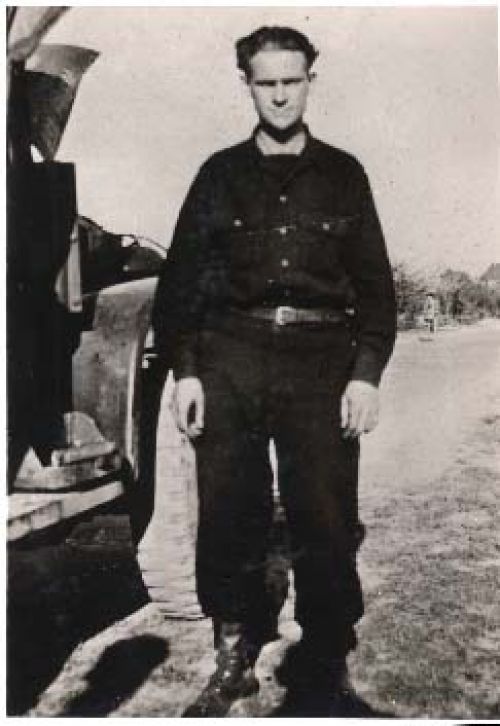
Werner Dubois
Born on 26 February 1913 in Wuppertal –Langenfeld. He was brought up by his grandmother. After school he worked as a joiner, brushmaker, printer and on a farm. He joined the SS in January 1937 and he worked as a driver for the Gruppenkommando Oranienburg, and he also served as a driver and a guard at the Sachsenhausen Concentration Camp.
In August 1939 he was transferred to the T4 organisation where he drove the buses and worked as a burner in a number of T4 institutions in Bernburg,Brandenburg, Grafeneck and Hadamar.
Following a brief spell in Russia working for the Organiasation Todt, and in April 1942 was transferred to the Belzec death camp, where he admitted shooting Jewish prisoners. In the summer of 1943 he was transferred to the Sobibor death camp, when Belzec was closed.
At Sobibor he was in charge of the Waldkommando and he was attacked in the armoury on the day of the prisoner revolt on 14 October 1943 and suffered serious wounds. Dubois was acquitted at the Belzec trial in August 1963. However, he was sentenced to three years imprisonment at the Sobibor trial in Hagen in 1966.
FLOSS, Erich Herbert
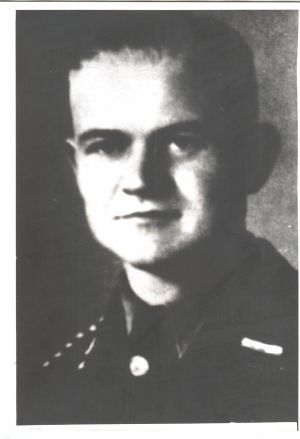
Born on 25 August 1912 in Reinholdsheim. He attended extended elementary school. After school he was trained in textile dyeing, but he could not secure a position in this line of work and consequently worked in several other jobs.
From 1 April 1935 he served in the 2 Totenkopfsturmban Elbe and saw service in the Buchenwald concentration camp and he also served at the T4 institution at Bernburg.
Erich Herbert Floss was to make a name for himself as the Aktion Reinhardt cremation expert which he put to good effect at Belzec, Sobibor and Treblinka death camps, during 1943. Floss was nicknamed by the Jews at Treblinka, as Tadellos (perfect); that was his favourite expression. Floss served mainly at Sobibor death camp He was one of the SS men who took the victims last possessions before they entered the 'Tube,' leading from Lager II to the gas chambers.
One week after the revolt Floss escorted a group of Ukrainian guards to the Trawniki training camp when he was killed by one of them in Zawadowka, near Chelm.
FORKER, Alfred
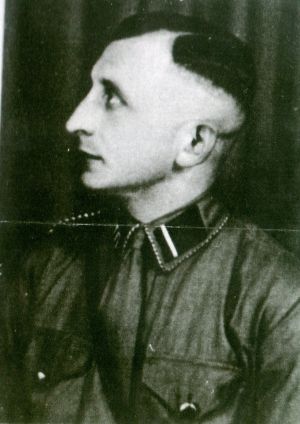
Born on 31 July 1904, in Sachsen. He served as a male nurse at the T4 insttution at Pirna /Sonnenstein. Forker served in Treblinka as a guard in the sorting yard, and in the Totenlager. Described in the testimony of his colleague Otto Horn, as being small, with a tapering peaky face and dark blond hair. He also served at Sobibor death camp, and when Sobibor was liquidated he was posted to Italy. No further details are known.
FRENZEL, Karl August Wilhelm
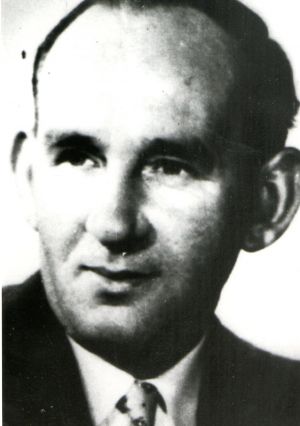
Born on 20 August 1911 in Zehdenick on the Havel, the son of a Reichsbahn employee, both his brothers were killed in the First World War. He took on a four year apprenticeship as a carpenter, but work in this field was difficult to find. He managed to find agricultural work, then became a driver for a butcher. He joined the Nazi Party and became an SA man from August 1930, and his fervent belief in National Socialism, he received a dagger of honour from Hitler personally, which he described as "his greatest experience."
At the end of 1939 he was employed by T4 and Frenzel first went to Grafeneck institution where he worked as a guard, he then went to another institution at Bernburg and then onto Hadanar, where he became involved in the gassing and cremating of mentally ill and disabled people. After returning to Bernburg to help dismantling the gassing facilities, in mid-
After a short while Frenzel was placed in charge of Lager I and the Bahnhofskommando, he was the one alongside Gustav Wagner, who selected the workers who were to live whilst the rest were consigned to the gas chambers. SS-
Frenzel, was one of the main targets of the prisoners during the revolt on 14 October 1943, but he escaped because he was in the shower. Because Franz Reichleitner was absent and deputy commandant Niemann was killed by the prisoners, Frenzel took command of the camp in the aftermath of the revolt.
Once Sobibor death camp had been dismantled and closed down, he was sent to join Globocnik in Trieste. He was assigned to Sondertruppe R as a Polizeihauptwachtmeister in Trieste and Fiume, hunting Jews and fighting partisans. In the spring of 1944 he was involved in a motor accident and spent a long time in a hospital in Udine. After being captured by the American forces he was taken to a Prisoner of War camp in the Munich area and made his way back to his home in Lowenburg in November 1945, the very day his wife Sofia died. He found employment as acting stage manager for a film studio in Gottingen. Frenzel was arrested for war crimes committed at Sobibor on 22 March 1962 and following a trial in Hagen he was sentenced on 20 December 1966 to life imprisonment. Karl Frenzel died in a retirement home in Garbsen / Hanover on 2 September 1996.
FUCHS, Erich
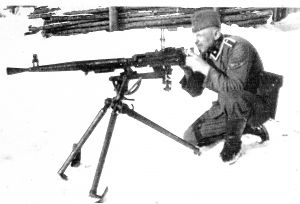
Erich Fuchs outside the Kommandantur in Belzec
Born on 9 April 1902 in Berlin. After his education in an elementary school he trained to become a skilled motor mechanic and automative foreman. Before the Second World War he was a driver in Berlin and he joined the Nazi Party in the early 1930's and became a member of the SA and later the SS
He was drafted to T4 he worked as Dr Eberl's driver in the T4 institutions at Brandenburg and Bernburg, and was, as he expressed himself, 'an interested spectator' at the gassing of 50 mental patients.
In the winter of 1941 Fuchs was selected at Bernburg by Christian Wirth and posted to Belzec death camp. At Belzec he installed the" showers" the disguised gassing facilties and worked as a truck driver, in the motor pool transporting material to the death camp site. In April 1942 he collected a Russian water-
Erich Fuchs was then posted to Treblinka to assist with the installation of an engine in the gas chamber, which he testified; "Subsequently I went to Treblinka. In this extermination camp I installed a generator which supplied electric light for the barracks. The work in Treblinka took me about three to four busy months. During my stay there transports of Jews who were gassed were coming in daily."
In December 1942 Fuchs managed to arrange his release from T4 and from early 1943 he worked for the German oil company Ostland – Ol-
Fuchs worked till 1962 at a number of jobs as an assistant worker, locksmith and truck inspector at the TUV in Koblenz, he was arrested and held in custody from 8 April 1963. The Schwurgericht am Landgericht Hagen sentenced him to four years imprisonment on 20 December 1966 for being an accessory to the murder of at least 79,000 people. He died in Koblenz on 25 July 1980.
GAULSTICH, Freidrich
Freidrich Gaulstich arrived in Sobibor in August 1943 and he was killed by a blow from an axe during the revolt on 14 October 1943 by Szlomo Leitman in the carpentry workshop.
GENTZ, Adolf
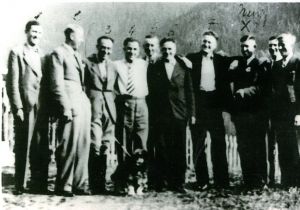
Adolf Gentz - First from Left -Attersee, Austria
Born around 1912, in Mark Brandenburg. Adolf Gentz served in Treblinka from August 1942 until October 1943. He served on the ramp at Treblinka. Richard Glazar recalled Adolf Gentz; If I imagine Gentz without the SS uniform, he could be a nice bright young man. I imagine him tossing his school bag into some corner and putting the field cap on his straight, bright red hair, buttoning his uniform jacket, grinning at the reflection in the mirror of the youthful freckled face with the strawberry blond eyebrows, and thinking, 'This is gonna be fun.' And when he got to Treblinka, and everyone around him eyed him with awe, then he told himself, 'Well, whadda ya know, this is fun.' After Treblinka was closed down Adolf Gentz was posted to the Sobibor death camp and assisted with the liquidation of that death camp. Then he served in Udine, Italy until the war ended. No further details known.
GETZINGER, Anton
Born on 24 November 1910 in Oeblarn, Austria. He was described by his Ortsgruppenleiter as a 'fanatical National Socialist and a fighter for the ideas of our Führer Adolf Hitler.' Getzinger served at the T4 institute at Hartheim, near Linz.
Getzinger arrived in Sobibor during April 1942 and he worked in Lager III. A few weeks before the revolt he was killed by a grenade in the Nordlager, where captured Soviet munitions were stored, in the presence of Hubert Gomerski, who explained what happened:
"We wanted to zero the aim of a machine-
To cover up this embarrassing incident, an official NSDAP report of 9 December 1944 stated that Getzinger was killed in action fighting against bandits, while serving in a Sonderkommando in Serbia.
GOMERSKI, Hubert
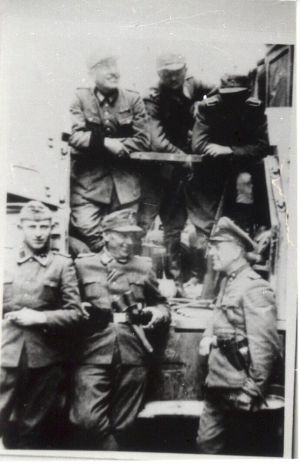
Hubert Gomerski - Far Right - Italy
Born on 11 November 1911 in Schweinheim and he worked at the T4 institutions at Hadamar and Hartheim. He arrived in Sobibor at the end of April 1942. Initially he was put in charge of a group of Ukrainian guards, but then worked alongside Bolender and Vallaster in Lager III.
Gomerski could be found on the ramp whenever a transport arrived, looking for the sick and disabled. He was known as 'the doctor' because of his past experience in handling the sick, and his speciality was braining the half dead with a steel water-
His accomplishments at Sobibor earned him promotion to the rank of SS-
The Schwurgericht in Frankfurt am Main sentenced him to life imprisonment on 25 August 1950 for murdering an undisclosed number of people. He asked for a re-
GRAETSCHUS, Siegfried
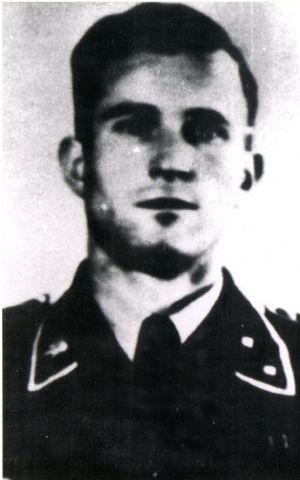
Born on 9 June 1916 in Tilsit, East Prussia. After extended elementary education, he became a farmer and was a member of the NSDAP from 1936. He served at the Sachsenhausen Concentration Camp, as confirmed by the War Crimes Group in 1947.
Graetschus was posted to the Belzec death camp and was involved in the early gassing experiments, including the conversion of a Post Office parcel van, into a gas-
GROMER, Ferdinand
Born on 7 April 1903 in Austria. He worked in the T4 institution at Hartheim. Gromer was posted to Sobibor in August 1942 as a cook. Although he carried out a number of roles at the death camp; overseeing the gassing and transporting the bodies to the mass graves and burying the corpses. He also supervised the Waldkommando. Erich Bauer recalled Gromer, "as a drunk who frequently resorted to violence." Commandant Reichleitner removed him from Sobibor because of his drinking problems. Possibly known as 'Red Cake' by the prisoners.
GROTH, Paul Johannes

Paul Groth - Far left celebrating
Born on 9 February 1922 in Holthausen, Schwein. He served at the T4 institute at Hartheim near Linz, Austria. Groth was posted to the Belzec death camp in January 1942. Christian Wirth transferred Groth to the Sobibor death camp in April 1942, where he supervised the sorting activities in Lager II. He was regarded by the prisoners as one of the worst sadists. However, Groth fell in love with a Jewish girl called Ruth, who was shot in Lager III. Groth was transferred back to the Belzec death camp in December 1942. Groth was in charge of the transport that brought the last Jewish work-
HACKEL, Emil
Born 0n 9 November 1910 in the Sudetenland. He served in the T4 institute at Pirna /Sonnenstein, as a 'burner.'He was transferred to the Sobibor death camp, but no other details are known.
HACKENHOLT, Lorenz
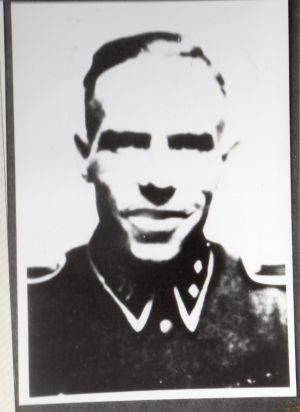
Lorenz Hackenholt - 1942
Born on 25 June 1914 in Gelsenkirchen. After attending the local elementary school until the age of 14 , he became an apprentice bricklayer and on passing the trade examinations worked on various building sites.
Lorenz Hackenholt joined the SS in 1934 and as part of the 2 Totenkopf Brandenburg Division was stationed at Oranienburg, north of Berlin, and he was transferred to the Sachsenhausen concentration camp in March 1938, where he was employed in the motor pool and as a driver for the camp command and personnel. In November 1939 he was summoned to Voss Strasse, along with Josef Oberhauser Siegfried Graetschus and Werner Dubois from the Sachsenhausen camp staff and was interviewed by Viktor Brack, the head of Hauptamt II of the Führer's Chancellery, and one of the men responsible for the Euthanasia programme, of killing mentally-
Lorenz Hackenholt drove the bus with SS NCO's in to the Grafeneck Castle institute in the Swabian Alps, south of Stuttgart. From the begining of 1940 when Grafeneck became operational until the summer of 1941 when the gassings were stopped on Hitler's orders, Lorenz Hackenholt served in all six T4 institutions, both as a bus driver and as a so-
After the termination of theT4 gassings, Hackenholt, together with a small group of SS NCO's from the Foundation, was transferred in the autumn of 1941 to serve the SS-
Lorenz Hackenholt rapidly became the gassing expert of Aktion Reinhardt, he was the one who started the motor which fed the three chambers with deadly carbon monoxide fumes, when the extermination camp became active in March 1942. A few months later he designed and supervised the construction of a new gas chamber building with six chambers, and which bore his name'Stiftung Hackenholt.' (Foundation Hackenholt). In August 1942 Lorenz Hackenholt was ordered to Treblinka by Christian Wirth, the Inspector of Aktion Reinhardt camps, in order to construct the larger gassing facility there. Erwin Lambert the T4 construction expert and Lorenz Hackenholt were then sent by Wirth to Sobibor death camp in order to build new gassing facilities there. After completing this task Hackenholt returned to Belzec death camp and he was subsequently involved in the exhumation and cremation of the gassed victims that had been buried in mass graves. In the spring of 1943 Lorenz Hackenholt returned to Treblinka on orders from Wirth to assist with the cremation operation. He was one of the excavator drivers.
Following the closure of Belzec in May 1943 Hackenholt was transferred to the Alter Flugplatz (Old Airfield) camp in Lublin, which was the main sorting, cleaning and storage depot for the vast amounts of belongings and valuables seized from the Jews murdered at Belzec, Sobibor and Treblinka. Valuable furs were disinfected with Zyklon B in four specially constructed chambers. After SS-
Whilst some of his former colleagues said in interrogations after the war had ended that Hackenholt had been kiiled in action, it would appear that he almost certainly survived the war and was living in the Allgau area around Memmingen – Kempten in the German – Austria border region. Was possibly spotted by his brother driving a delivery van. Lorenz Hackenholt has never been brought to trial and no further information is known.
HIRTREITER, Josef 'Sepp'

Sepp Hirtreiter - far right - Treblinka
Born on 1 February 1909 in Bruchsal, which is 20 kilometres north east of Karlsruhe. After attending extended elementary school. He trained as a locksmith but failed the final examination. Later he worked as an unskilled construction worker and bricklayer. On I August 1932 he became a member of the NSDAP and SA.
In October 1940 he was ordered to the Hadamar institute where he worked in the kitchen and the office. In the summer of 1942 he was drafted into the Wehrmacht for a brief time before returning to Hadamar and then onto Berlin where Christian Wirth transferred him to Lublin and then onto Treblinka death camp.
Josef Hirtreiter was stationed at Treblinka from 20 August 1942 until October 1943 when he was transferred to Sobibor death camp to assist with the dismantling of that camp. At Treblinka he became much feared by the Jewish prisoners, and he was known by the nickname 'Sepp'.
In October 1943 he was ordered to Italy where he joined an anti-
Among the crimes he was found guilty of were killing many young children, aged one or two, when during the unloading of transports, by seizing the infants by their feet and smashing their heads against the boxcars. Because of ill-
HÖDL, Franz

Franz Hodl, middle in Italy
Born on 1 August 1905 in Aschbach, Austria. He served at the T4 institute at Hartheim, where he drove the buses from April 1939 to January 1942. Thereafter he was drafted to an Organisation Todt unit in Russia where he was employed transporting wounded soldiers.
After a period of training at the Trawniki SS-
ITTNER, Jakob, Alfred

Alfred Ittner left with Paul Groth
Born on 13 January 1907 in Kulmbach. He joined the Nazi Party as early as 1926 and the SA in 1936 as a Scharführer. After working for T4 in Berlin as a book-
He spent the first five weeks in administrative duties as an SS-
At the end of June 1942 he managed to get himself transferred back to T4 headquarters in Berlin. In the 1966 Hagen Trial he was sentenced to four years in prison for his part in the murder of an 'undisclosed number, though at least 68,000 Jews.'
JUHRS, Robert Emil
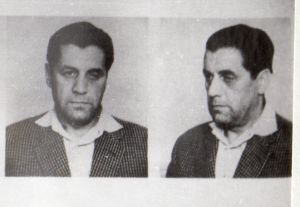
Born on 17 October 1911 in Frankfurt am Main. By profession he was a painter, but he also worked as a labourer, caretaker, and usher at the Frankfurt Opera House and an office clerk. After serving at the T4 institute at Hadamar, where he was employed as a male nurse, painter and clerk until late 1941.
He was posted to the Belzec death camp in June 1942, where he served at the ramp and at the Lazarett shooting the sick and disabled.
In March 1943 he was posted to the Jewish labour camp at Dorohucza, where peat was dug and he remained until early November 1943. Juhrs escorted the Arbeitshaftlinge from Dorohucza to Trawnki, where all of them were shot during Aktion Erntefest (Harvest Festival).
Following the revolt in Sobibor in October 1943, Juhrs was sent to Sobibor to help with the dismantling of the camp and he formed a guard cordon of the last prisoners to be killed at Sobibor, once they had finished with the clean-
Juhrs was ordered to Italy in December 1943. He was acquitted at the Belzec Trial at the Landgericht Munich in 1963 and he was also acquiited at the Sobibor Trial in Hagen on 20 December 1966 on charges arising from his involvement in the demolition of the camp.
KAMM, Rudolf
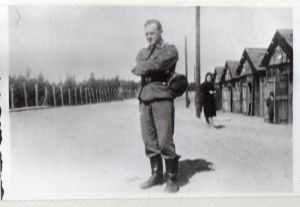
Rudolf Kamm at Belzec near the Sorting Sheds
Born in 1905 in Sedenz, a village near Teplitz Schonau in the Sudetenland. He served at the T4 institute at Pirna /Sonnenstein as a 'burner.'
He was posted to the death camp at Belzec in 1942 and records from the nearby hospital at Tomaszow Lubelski show that he was hospitalised on 17 June 1942 until the 25 June 1942 and again on the 30 December 1942 until the 31 January 1943 with typhus. *
He was transferred to Sobibor in 1943 where he supervised the sorting barracks. He was posted to Italy. Franz Suchomel testified that he saw him for the last time after the end of the war, in a Gasthaus between Mauthern and Hermagor, Carinthia (Austria), the last lodgings of our former unit (R-
*Note; A number of the SS garrison were also hospitalised at Tomaszow Lubelski, including Schwarz and Unverhau as well as Kamm, and a number of Trawniki – manner were also hospitialised, and some of them died of typhus.
KLIER, Johann
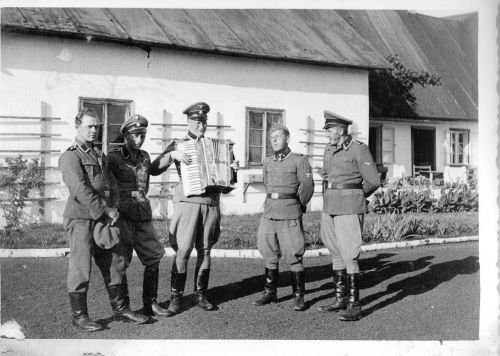
Klier far right in front of the New Casino
Born on 15 July 1901 in Stadt Steinach. After completing school he qualifed as a master baker. From 1934 until 1940 he worked at the Heddernheimer Copper Works factory and in the same year he was posted to the T4 institute at Hadamar, where he worked as a construction worker and looking after the heating system.
He was posted to Sobibor early in August 1942. He was in charge of the bakery, first outside and later inside Lager I. He also supervised the sorting and storage of the shoes in Lager II. Klier was on leave when the prisoner revolt took place on 14 October 1943 and when Sobibor was closed, he was posted to Italy. Klier was regarded as relatively humane by the prisoners and they testified to that effect at his trial in Frankfurt am Main, and on 25 August 1950 he was found not guilty. Klier died on 18 February 1955.
KONRAD, Fritz
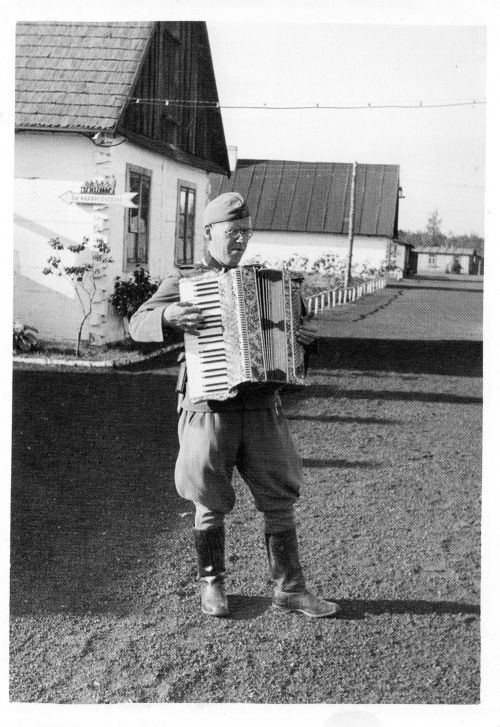
Fritz Konrad in Sobibor
Born on 21 September 1914, he served in the T4 institutes at Pirna /Sonnenstein and Grafeneck as a male nurse. He was posted to Sobibor death camp in March 1943, along with the Wolf brothers and Willi Wendland. He worked both as a supervisor in the sorting barracks in Lager II and in Lager III. Sobibor survivor Zelda Metz testified that he was killed by one of the shoemenders during the revolt.
LACHMANN, Erich, Gustav Willie
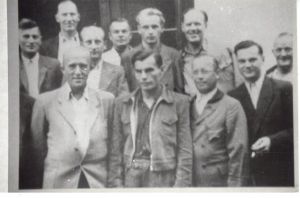
Erich Lachmann - Second from left back row
Born on 6 November 1909 in Liegnitz. A member of the police he trained Ukrainian volunteers at Trawniki from September 1941 and he testified he was only at Sobibor for only a few months from August 1943, as Oberwachtmeister and chief of the Ukrainian guards. However, it has been confirmed that in fact he was there a year earlier.
Bauer recalled that Lachmann was a theiving alcoholic, Jewish survivors Marguiles and Lichtman witnessed him raping young girls. Commandant Reichleitner sent Lachmann back to Trawniki because of his incomptetence, from where he deserted with his girlfriend . In the Hagen Trial of 1966 he was acquitted. He died on 23 January 1972 in Wegscheid.
LAMBERT, Erwin Hermann
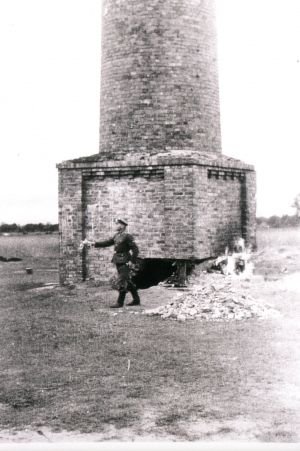
Erwin Lambert - Malkinia - Destruction of Glass Factory Tower
Born on 7 December 1909 in Schildow, Kreis Niederbarnim, near Berlin. He was a member of the NSDAP since 1933 and a mason by profession. In January 1940 he was recruited to T4 and his first assingment was the renovation of the T4 villa in Tiergartenstrasse 4. He installed the gas chambers at the institutes of Hartheim, Pirna/ Sonnenstein, Bernburg and Hadamar.
In the Spring of 1942 he was ordered to Lublin and then onto the Treblinka death camp, he arrived there with August Hengst, and under the command of Richard Thomalla was responsible for construction work on the first gas chambers and other buildings. In August 1942 he was responsible for the demolition of a glass factory chimney in Malkinia, which was photographed by Kurt Franz, and the bricks were used in the construcion of the larger gas chambers building in Treblinka. He was called the 'Flying Architect of T4,' because he also undertook construction works at T4 establishments, such as the villa used for recreation by the death camp personnel at Attersee.
Erwin Lambert also was involved along with Lorenz Hakenholt in the construction of larger gassing facilities at the Sobibor death camp, as well as as general construction work in the Jewish Labour camps at Dorohucza and Poniatowa. After Aktion Reinhardt ended he was posted to Trieste, Italy. Afer the war Lambert was arrested on 28 March 1962 and was tried at the Treblinka Trial which was held in Dusseldorf during 1964/1965. He was found guilty and sentenced to four years in prison.
LUDWIG, Karl Emil
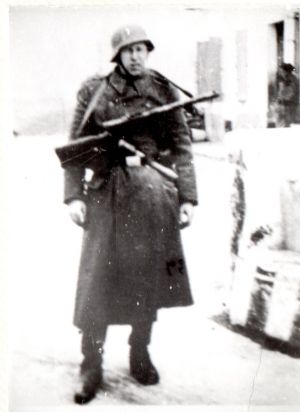
Karl Ludwig in Italy
Born on 30 November 1904 in Storkow. A driver by profession he was the chauffeur of Reichsleiter Martin Bormann and for T4 headquarters. He was posted to the Sobibor death camp from April 1942 until January 1943 where he served in Lager III, the extermination area. In January 1943 he was posted to Treblinka, where he also served in Lager II, the extermination area. Joe Siedlicki recalled in an interview with Gitta Sereny, that Karl Ludwig was; "He was a good, good man. The number of times he brought me things, the number of times he helped me, the number of people he probably saved, I can hardly tell you." After Treblinka death camp was dismantled he served in Italy, he survived the war.
MATTHES, Heinrich Arthur
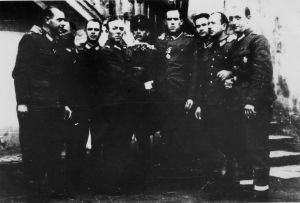
Heinrich Matthes - Fourth from left - Trieste with Lorenz Hackenholt
Born on 11 January 1902 in Wermsdorf, Kreis Leipzig. He attended extended elementary school and became a tailor. In 1924 he served an apprenticeship as a male nurse and educator and took his examinations at the mental home Pirna/ Sonnenstein near Dresden.
At the psychological clinic in Arnsdorf, also near Dresden he served as a male nurse and educator. In 1930 he worked as an educator and welfare worker to an institute in Braunsdorf, near Freiburg / Sachsen, returning in October 1933 to Arnsdorf. Heinrich Matthes became an SA member in 1934. In 1939 he was drafted into the Wehrmacht, where he served as a soldier in Poland and France until September 1941. His last rank in the Wehrmacht was Obergefreiter.
Released from the Wehrmacht, Matthes was ordered to the Kdf (Kanzlei des Führer) where he was posted to the T4 organisation. He spent a short time in the photograph section. In the winter of 1941/42 he served as a member of the Organisation Todt, in Russia, where he served as a male nurse in the Minsk and Smolensk areas. In February / March 1942 he returned from Russia and served in the same photograhic section at T4.
In August 1942 he was ordered to Lublin, where he was drafted into the SS and given the rank of SS-
From Treblinka he was posted to the Sobibor death camp in September 1943 where he stayed until the camp was dismantled and afterwards was stationed in Berlin. In early 1944 he was posted from Berlin to Trieste in Italy, now with the rank of Polizei –Oberwachtmeister. In Trieste he fought against partisans, took part in millitary construction work and served as a guard until the end of the war.
n 1945 he was captured by US forces, but was released the same year. Returning to Germany in Nuremberg he worked as an ambulance man, helped removing rubble and was employed as a male nurse again, at the mental homes in Ansbach, Andernach and finally Bayreuth. In the Treblinka Trial held during 1964/65 in Dusseldorf he was sentenced to life imprisonment.
MATZIG, Willy
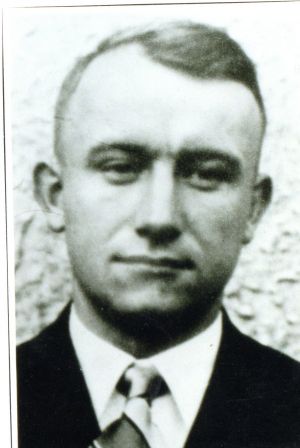
Born on 6 August 1910 in Berg, Oberlausitz. After leaving school his first profession was as a glasscutter. In October 1933 he became a member of the Allgemeine SS with the rank of SS-
In Berlin recruited as a member of T4 from February / March 1940 and he served as a guard at the Brandenburg institute for one year, and in 1941 was posted to Bernburg, where he again served as a guard and an admistration assistant until August 1942.
In August 1942 he was posted to Treblinka death camp where he performed book-
Following the dismantling of Treblinka he was in Sobibor for a short while, and then in Trieste till the end of the war. No further details known.
MENTZ, Willi

Willi Mentz - Second from left - Treblinka
Born on 30 April 1904 in Schonhagen, Kreis Bromberg. After school he found employment as an unskilled worker in a sawmill and then passed his master milkman's examination. In 1940 he took care of cows and pigs at the Grafeneck institute and from 1941 to early summer 1942 worked in the gardens at Hadamar.
From June – July 1942 he was posted to Treblinka death camp where he was assigned at first to Camp II and then to Camp I as chief of the Landwirtschaftskommando (Agricultural Commando). Willi Mentz was also assigned by Wirth to supervise the Lazarett, where he became one of the most brutal killers, much feared by the Jewish prisoners.
After Treblinka was dismantled he served for a short time at Sobibor death camp and from there he was posted to Italy, fighting partisans and persecuting Jews. After the war ended he worked again as a master milkman. In the Treblinka trial held in Dusseldorf during 1964/65 he was sentenced to life imprisonment.
MICHEL, Hermann
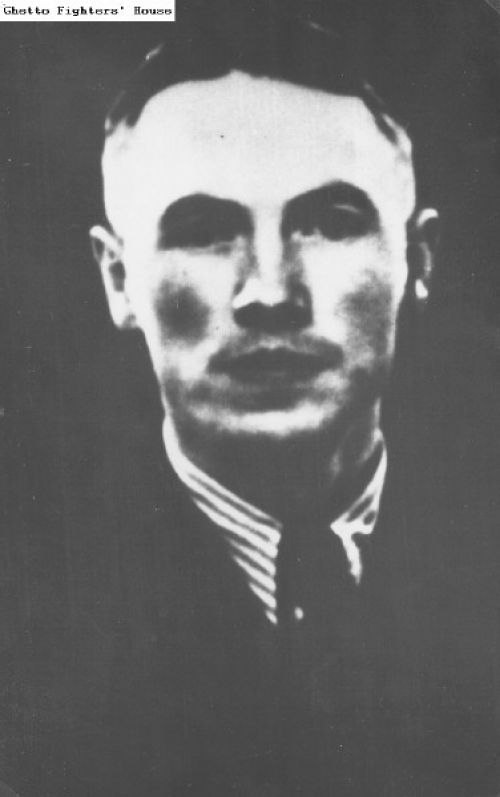
Hermann Michel known as the 'preacher' in Sobibor
Born during 1906, in Heegermuhle. Hermann Michel was a T4 man who served at Grafeneck and Hartheim institutes. He was posted to the Sobibor death camp from April 1942, and he was a friend of Franz Stangl, the first commandant of Sobibor. He used to welcome the new arrivals in Lager II with a short speech in order to win their confidence by pretending that they had arrived at a labour camp and must be disinfected and bathed for reasons of hygiene.
He was later transferred to Treblinka in November 1942. After the war he fled to Egypt. No further details known.
MUELLER, Adolf
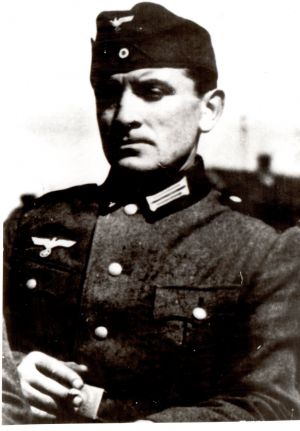
Born during 1902, in Berlin. He worked for T4 as an usher. Adolf Mueller arrived in Sobibor in the summer of 1943. He served mosty in Lager II, in the sorting barracks and in charge of the Waldkommando. During the revolt he kept a group of prisoners of the Waldkommando under armed guard.He died on 10 March 1949 in Berlin. He probably also served at Treblinka in the camp administration. Also served in Trieste, Italy
NIEMANN, Johann
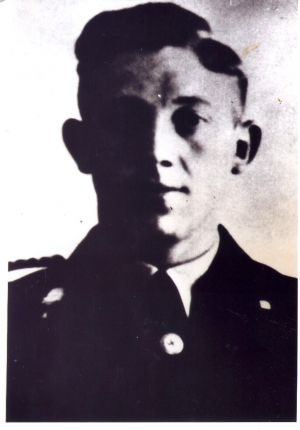
Born on 4 August 1913 in Wollern Ostfriesland. He served at a number of concentration camps such as Oranienburg, Esterwegen and Sachsenhausen between the years 1934 – 1941. He was a member of T4 and was employed as a 'burner' at the Bernburg institute.
Niemann was posted to service in the east at the Belzec death camp before being posted to Sobibor in January 1943. Niemann was promoted to the rank of SS-
NOWAK, Anton Julius
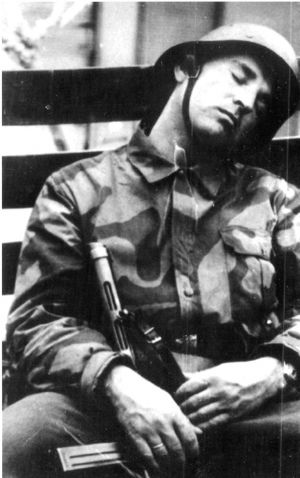
Born on 22 May 1907 in Janow. He supervised the 'haircutters' barracks near the gas chambers. Sometimes he supervised the Waldkommando. Survivor Estera Raab often saw him going into Lager III and said he stank of dead bodies. Anton Nowak was killed during the revolt on 14 October 1943.
NOWAK, Walter
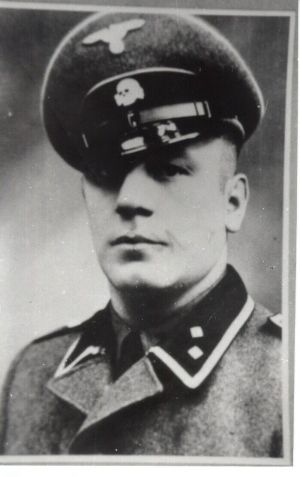
Born on 12 May 1912, in Dresden. He worked at the T4 institute at Pirna /Sonnenstein, as a male nurse. He was posted to the Sobibor death camp. During the euthanasia trials in Dresden in 1947, his service in Sobibor was not included in the indictment. The fact that her served in Sobibor came to light in a letter dated 6 March 1946 from the local police in Pirna, it noted that during the interrogation of his wife, she had admitted that her husband had served in the SS-
His comrade Paul Rost confirmed that Nowak had served in Lager III and that he had come across Walter Nowak after the war in an American Entlassungslager. After his release in 1947 he was pursued by the authorities but without success.
POST, Philipp
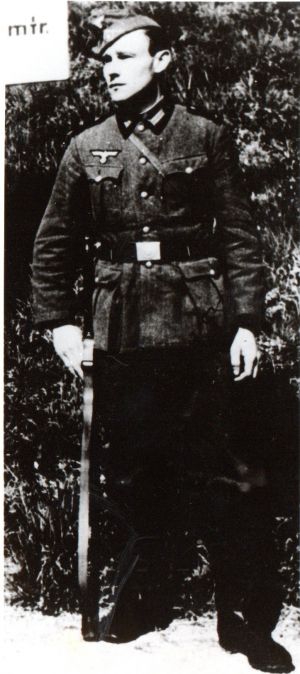
Born during 1911, in Bad Vilben, Hessen. He served in Treblinka between August 1942 and September 1943. He served in Sobibor from September 1943, until the camp closed. Philipp Post held the rank of a Polizeioberwachtmeister and in a police report dated March 1945, intercepted by British Intelligence he was described as circa 32 years of age, from the Frankfurt am Main area, about 1.73 meters tall; well built with brown hair and a rather red face. Philipp Post arrived in Treblinka on 20 August 1942 and according to Kurt Franz, Post served in Camp I as a weapons guard and when Treblinka was closed he served in Italy fighting the partisans.
PÖTZINGER, Karl
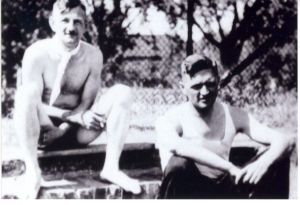
Karl Potzinger right next to Willi Wendland
Born in1908, in Marktredwitz. Recruited into T4 he served at the Brandenburg and Bernburg institutions, where he incinerated the bodies. He was posted to Treblinka, during May / June 1942, where he worked in the Totenlager, in charge of the burial pits, then the cremations. When Treblinka was closed he served briefly in the Sobibor death camp, before being posted to Italy. Karl Pötzinger was killed on 22 December 1944 in an air-
REHWALD, Wenzel (Fritz)
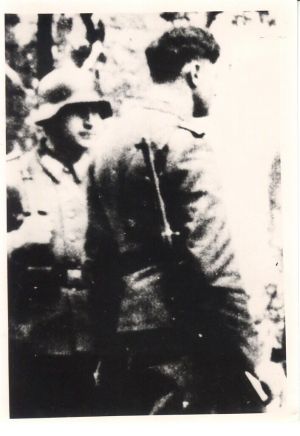
Born during 1910, possibly in Moldau. A bricklayer by profession. He joined T4 Euthanasia programme and served at Bernburg, Hadamar, Hartheim and Pirna /Sonnenstein instutions. Posted to Sobibor death camp in April 1942. He supervised the women's undressing barrack and the construction of new barracks. During the revolt he held prisoners under guard at gunpoint. After Sobibor was dismantled he was posted to Italy.
RICHTER, Kurt
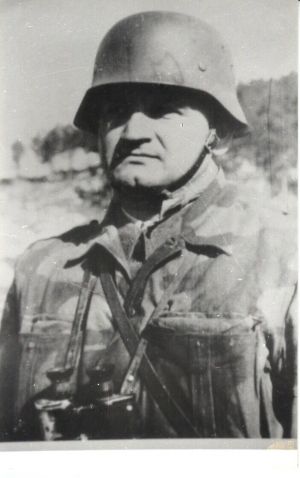
Kurt Richter in Italy
Born during 1914, in Karlsbad, Bohemia. He was by profession was a butcher. He was recruited into T4 and served at Pirna/ Sonnenstein and Hartheim institutions. Posted to the East, he first went to Treblinka death camp as a cook, and was transferred to Sobibor death camp in December 1942. At Sobibor he used to take the sick from the Ramp to the Lazarett, and he also supervised the work in the 'haircutters' barracks and took part in the execution of the workers in the Waldkommando.After Sobibor he was posted to Italy, and he was killed in a fight with partisans on 13 August 1944 near Trieste. Erich Bauer testified that he transported Richter's body to the local cemetery.
ROST, Paul

Paul Rost far right at the Sorting Barracks
Born on 12 June 1904 in Deutschenbora near Meissen. After attending extended elementary school he trained to become a butcher. In 1925 he became a member of the police in Dresden and in 1937 became a member of the Nazi Party. On 21 May 1940 he was posted to the Pirna/ Sonnenstein institute , where he commanded the police squad and transportation command. He also served at Hartheim institute
Rost was posted to Sobibor death camp in April 1942, he was initialy the deputy commandant but was succeeded by Floss and Niemann respectively. He supervised the sorting of Jewish property in Lager II and also had to secretly spy on the other SS staff. He was transferred to Treblinka in May 1943; Rost was transferred to Trieste in December 1943 and he was promoted to police lieutenant on 9 November 1944 and awarded the Kreigsverdienstkreuz class II.
After the war had ended he was a Prisoner of War in a US ran camp but was released and returned to his family in Dresden. He was subsequently imprisoned by the Soviet Millitary Authority until the summer of 1946, then once again released. He lived and worked untroubled in Dresden until his death on 21 March 1984.
RUM, Franz Albert
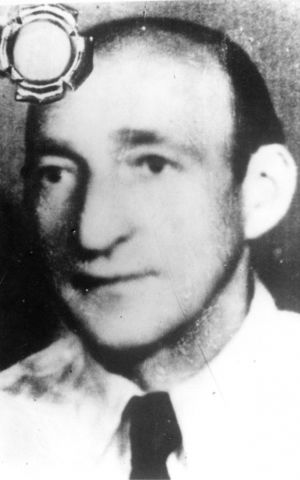
Born on 8 June 1890 in Berlin. By profession he was a waiter in a night-
He was posted to Treblinka death camp in December 1942 where he supervised the Body – Transport commando, in the Totenlager, and he also chased the Jews into the gas chambers with a whip in hand. He was also in charge of Sorting Barracks B in the Sorting Yard. He took part in the final liquidation of Treblinka and was in the truck with Kurt Franz that went to the Sobibor death camp in November 1943.
Rum was then posted to Trieste, Italy and returned to Germany after the war. He was tried in the Treblinka Trial held during 1964/65 in Dusseldorf and was sentenced to three years in prison. He died in 1970.
RYBA, Walter
Born on 18 July 1900 in Heydebreck, Kozle. He was killed in the garage during the prisoner revolt at the death camp on 14 October 1943. According to the Berlin Document Centre his name was Walter Hochberg.
SCHAFER, Herbert
Born between 1902 and 1909. After service in T4 he served in the SS Training Camp at Trawniki. He served in Sobibor between April and June 1942, as leader of the Trawniki -manner guard unit. No further details known.
SCHARFE, Herbert
Born on 13 February 1913 in Konigstein, Sachsen. He served at the T4 institute at Pirna / Sonnenstein, employed in the economics office. Sent to the Treblinka death camp he was in charge of the camouflage commando. He also served at Sobibor death camp. No further details known.
SCHIFFNER, Karl

Karl Schiffner - Third from left - Trieste
Born on 4 July 1901 in Weiskirchlitz, under the name of Kresadlo. He attended extended elementary school and later at the public school in Weiskirchlitz. He served a three year apprenticeship as a carpenter at a Trade school. He then served in the Czech army during the years 1921 -
Until 1942 he served at the T4 institute at Pirna / Sonnenstein and was then sent to Treblinka, where he was in charge of the camp joinery and construction team. During June / July 1943 he anda group of twelve Ukranians under his command went to Belzec to supervise the construction of a farmhouse on the former camp site, which was to be occupied by a Ukrainian family to keep a close watch on the site.
He also served at the Sobibor death camp and from there he was posted to Trieste, in a police unit, which fought partisans until the end of the war. Schiffner made his way to Karnten, Austria where he was captured by the British, and interned in a Prisoner of War camp at Usbach. He was released in October 1945, he made his way to Salzburg and disappeared. No further details known.
SCHMIDT, FRITZ
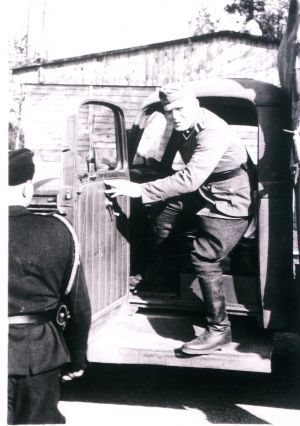
Fritz Schmidt in Treblinka
Born on 29 November 1906, in Eibau, Saxony. He was employed in the T4 Institute at Pirna/ Sonnenstein in 1940, as a guard and driver and in 1941, he was transferred to the T4 institute at Bernburg. He was posted to Treblinka in the summer of 1942. In Treblinka he served in the Totenlager, where he supervised the gas chambers. He was also in charge of the garage and was chief of the metal workshop. He was transferred to Sobibor during September 1943, until the camp was liquidated. He was then posted to Trieste, Italy and was captured by the Americans at the end of the war, but was released and he returned to Germany. He was arrested in Saxony and put on trial. On 14 December 1949, he was sentenced to nine years in prison, but he escaped and went to West Germany, where he lived undisturbed until his death on 4 February 1982
SCHULTZ, Erich
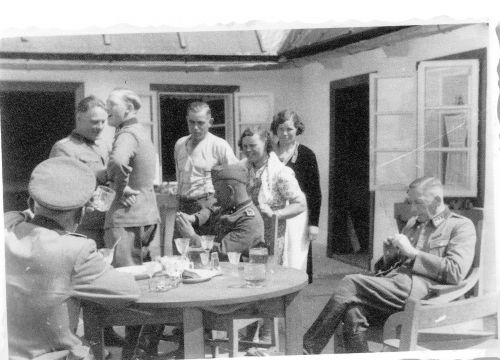
Reichleitner, Niemann, Schultz, Bauer, unknown border official - New Casino
Born on September 3, 1902, in Adlershof, Berlin. Employed from 1940, at the T4 euthanasia institutions at Grafeneck, Hadamar and Pirna- Sonnenstein as a 'burner' of corpses in the crematoria. Transferred to Treblinka where he was employed as a platoon leader from September 1942, until the spring of 1943.
He was then transferred to Sobibor death camp where he supervised the Waldkommando and the Strafkommando. When the camp was liquidated in November 1943, he served in Einsatz R in northern Italy. Nothing is known of his whereabouts after the War
SCHUTT, Hans-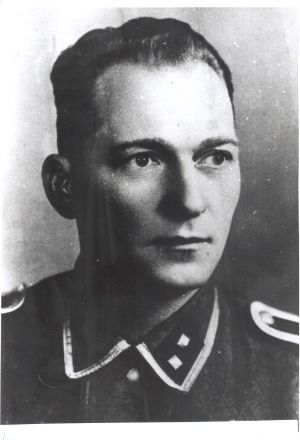
Born on 6 April 1908 in Dummersdorf. As early as 1938 he became a Sturmbannverwaltungsführer with the SS and subsequently Verwaltungsführer in the T4 institutes at Grafeneck and Hadamar. From 28 April 1942 until mid-
SCHWARZ, Gottfried
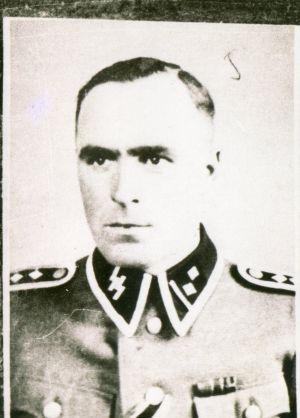
Born on the 3 May 1913 in Furth/ Bayern. He served at Grafeneck and Bernburg psychiatric institutions as a "burner". He was posted to Belzec death camp, Schwarz and Oberhauser greeted Wirth on his arrival at the site of the future death camp. Schwarz was one of the most brutal SS-
Schwarz also served at the Sobibor death camp and was there when Erich Fuchs tested the gas chamber engine, in the spring of 1942. Schwarz was appointed the Commandant of the Dorohucza labour camp, and after Aktion Reinhardt ended, he was posted to Italy. On the 19th June 1944 he was killed in action at San Pietro, and was buried at the German Military Cemetery at Costermano, near Verona.
SIEFERT, Rudolf
Born on 29 July 1913. He was a male nurse at Pirna / Sonnenstein. He served in Sobibor death camp, but no other details known.
STEFFL, Thomas
Born in Krummau in the Sudetenland, now Czech Republic and he arrived in Sobibor death camp in February 1943. He first served in the Treblinka death camp and arrived at Sobibor shortly before the prisoner revolt on 14 October 1943. Franz Suchomel was the only person who named this SS man and stated he was killed during the revolt.
STENGELIN, Erwin
Erwin Stengelin was born on 10 August 1911 in Tuttlingen. He seved a the T4 institute at Hadamar. He was posted to the East and served at the Treblinka death camp where he was assigned to Camp I. He was transferred to Sobibor death camp in September 1943 and he was killed during the prisoner revolt on 14 October 1943.
STEUBL, Karl
Born during 1910, in Linz. Karl Steubl was a member of T4 and was employed as a male nurse at the institute at Hartheim. He was posted to Sobibor in April 1942 and he served there until the camp was dismantled. He supervised the sorting of clothes in Lager II, and was described by Dov Freiberg, as a tall thin Austrian. Steubl witnessed the murder of the Jews from Treblinka who were assisting with the dismantling of the structures. He committed suicide after the war ended on 24 September 1945 in Linz, Austria.
SUCHOMEL, Franz
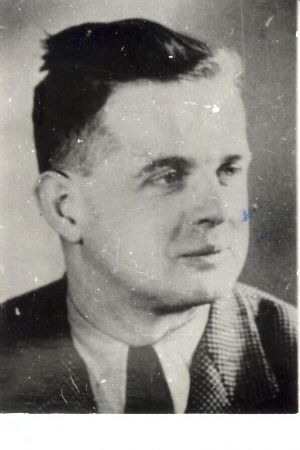
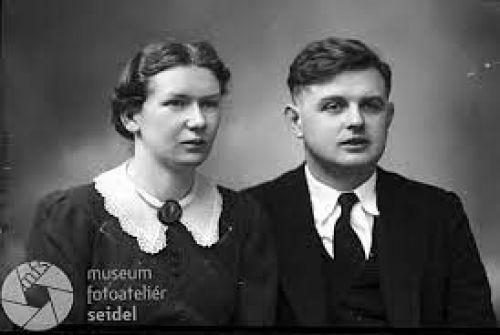
Suchomel marries Maria Pschiebl on February 11, 1939, in Krummau
Born on 3 December 1907 in Krummau, Sudetenland, now the Czech Republic. By profession he was a tailor. He worked from 1940 until 1942 in the T4 in Berlin and at the Hadamar institute.
Ordered together with Hirtreiter, Post, Loeffler, Sydow, Matthes and two men from Frankfurt am Main, they arrived in the Treblinka death camp on 20 August 1942. Initially he was employed at the unloading ramp, then as a supervisor in the women's undressing barracks, leading the victims to the 'Tube.' Later he was in charge of the Goldjuden, and the tailor shop. When Adolf Eichmann and Odilo Globocnik visited Treblinka, Suchomel had to report to them about the work of the Goldjuden. In late October 1943 he was ordered to the Sobibor death camp. After the closure of Sobibor he was posted to Trieste, Italy.
At the end of the war he was captured by US forces and incarcerated in a Prisoner of War camp. In August 1945 he was released and he returned to Germany. Since 1949 he lived in Alotting, in Bavaria, which was where he was arrested on 11 July 1963. In the Treblinka Trial 1964/65 he was sentenced to six years in prison, but was released in 1969.
SYDOW, Hermann
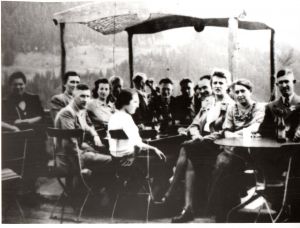
Hermann Sydow first left at Lake Attersee, Austria
Born either in 1899 or 1900, in Mark Brandenburg. After serving in T4, he was posted to Treblinka in August 1942, and he served there until October 1943. According to Richard Glazar Sydow was a docker from Hamburg, and at Treblinka he was in charge of the camouflage commando. Glazar recalled that Sydow was a short little guy, but very tough, with an unbelievable appetite for alcohol. After Treblinka closed down, he was posted to Sobibor, and after that camp closed he was posted to Italy. No further details known.
THOMAS, Martin
Martin Thomas served at the T4 institutes at Hadamar and Pirna/ Sonnenstein as a driver. He was posted to Sobibor death camp, no further details known.
UNVERHAU, Heinrich

Heinrich Unverhau in the middle with the accordion by the New Casino
Born on 26 November 1911 in Vienenburg, Goslar. In April 1925 he became a plumber's apprentice, but as a result of an accident at work, he lost the sight in his right eye, and he was forced to end his apprenticeship. He became a muscian and from 1934 he worked as a nurse.
In January 1940 he was ordered to join T4 and he was employed at Gafeneck and Hadamar institutes, as a nurse. In the winter of 1941 /42 he was drafted to the Eastern Front for service in the Organisation Todt looking after the wounded in Raume Wjasma.
In June 1942 he was posted to the Belzec death camp and whlst there in November 1942 he was hospitalised at Tomaszow Lubelski with spotted typhus and this disease caused him to lose his right eye completely. At the death camp he was responsible for sorting the possessions in the railway sheds located just outside the death camp, opposite Belzec railway station.
In the summer of 1943 he was posted to the Sobibor death camp where he supervised the cleaning up the undressing area in Lager II and in one of the sorting barracks. Unverhau was ordered back to the former death camp site at Belzec to help with the planting of trees to erase the traces of the crimes committed there. He repeated this role at the Treblinka death camp in September 1943 returning to Sobibor in November 1943, just in time to help with the re-
VALLASTER, Josef
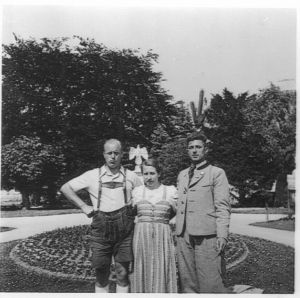
Josef Vallaster far right at his wedding
Born on 5 February 1910 in Silbertal, Austria. He served in the T4 institutes of Hadamar and Hartheim. He was posted to Belzec and then Sobibor in April 1942. He worked in Lager III, supervising the gassing and burial – later burning – of the victims. He often drove the narrow-
VEY, Kurt
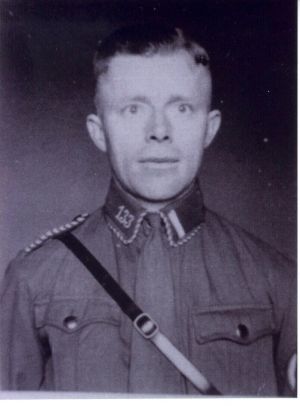
Born on 12 July 1901. He worked in the T4 institutes at Pirna / Sonnenstein in the office. He was posted to the Belzec and Sobibor death camps and after Sobibor was closed he was posted to Italy. No further details known.
WAGNER, Gustav Franz
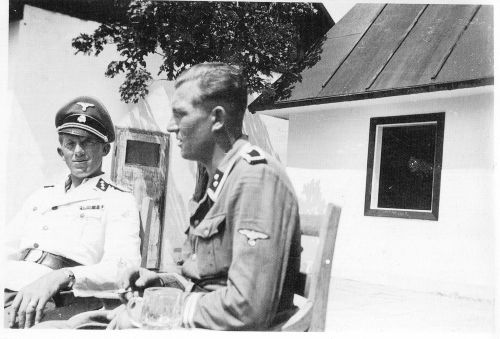
Johann Niemann and Gustav Wagner on the terrace at the New Casino
Born on 18 July 1911 in Vienna, Austria. He joined T4 and he was employed in the institutes at Hadamar and Hartheim. He was posted to Sobibor death camp in April 1942. His robust posture earned him the nickname Welfel (Wolf) and among the Arbeitshaftlinge he was regarded as the most brutal and dangerous SS men alongside Gomerski and Frenzel. Along with Frenzel he would select workers on the Ramp, either for Sobibor or Dorohucza or Lublin.
Heinrich Himmler promoted Wagner to the rank of SS-
He played a leading role in the execution of the Arbeitshaftlinge from Treblinka who were dismantling the facilities. After the end of the Second World War ended he fled to Brazil, having adopted the name of Gunther Mendel. In May 1978 he was traced by Simon Wiesenthal, the renowned Nazi-
Confronted with the evidence against him, he had to admit to being Wagner from Sobibor. He was duly arrested, but requests for his extradition to the German Federal Republic and Israel could not be met because early in October 1980, according to official Brazilian records, Wagner committed suicide in Itabaia, Brazil. Shlomo Szmajzer however, stated that he had not been an entirely passive bystander at his death.
WALTHER, Arthur
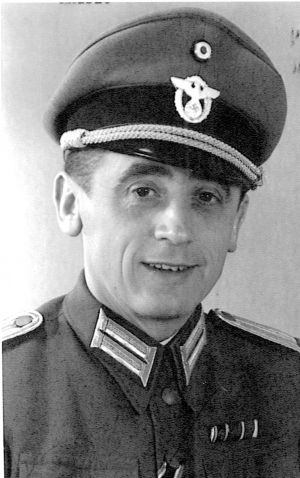
Born on 20 October 1907 in Reichstein. A Reserveleutnant der Schutzpolizei. He served in the T4 institutes at Pirna / Sonnenstein and Hartheim. He served in the Sobibor death camp and when the camp closed was posted to Italy. No further details known.
WEISS, Bruno
Born between 1905 and 1910. Lived in Berlin. Bruno Weiss was posted to Sobibor in April 1942 and during the early phase of the death camps operation he was the chief of Lager I, but Frenzel took over this function. He then served in Lager III, the extermination area.
He mocked the Jews through songs such as 'Gott. Du unser Lieber, erhore unsere Lieder, mach demJuden die Klapp zu, dann haben die Menschen Ruh.' (Dear God, hear our song, shut up the Jews so people will have some peace and quiet. According to a statement by Alfred Ittner on 17 July 1962, Bruno Weiss was in Lager III in Sobibor. He was released from T4 because he had tuberculosis. He left the camp in early 1943.
WENDLAND, Wilhem

Willi Wendland left with Karl Potzinger
Born 1907, in Berlin. Wilhem Wendland arrived in Sobibor death camp in March 1943 along with the Wolf brothers and Fritz Konrad. He supervised in the sorting barracks and also he supervised the Waldkommando, on the day five prisoners escaped. During the revolt on 14 October 1943, he held prisoners at gunpoint. He was posted to Italy.
WOLF, Franz
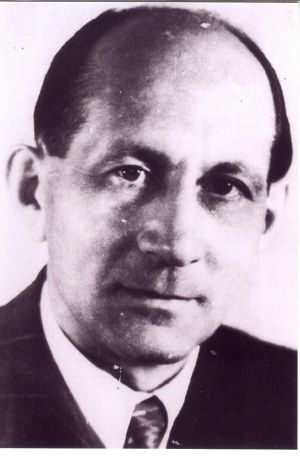
Born on 9 April 1907 in Krumau Sudetenland. He was a photographer and took over the families photographic business when his father died. He served in the Czech and German army. He served in the T4 killing centre at Hadamar and a physiciatric clinic in Heidleberg, where he took 'scientific' photographs of the mentally ill.
He was sent to Lublin, Poland with a small group of men, and from there he was posted to Sobibor in early March 1943, along with his brother Josef, Franz Konrad and Willi Wendland. Franz Wolf usually supervised in the sorting barracks. He would mock the women who worked there with the saying; 'Dalli, dalli, meine Damen; Arbeit macht das Leben suss.' (Come along now, girls, work makes life worth living.)
He also served in the barrack near the gas chamber, where the women had their hair cut and he also sometimes supervised the Waldkommando. He survived the revolt, on 14 October 1943, but very quickly after the revolt he was posted to Italy. In 1966 the court at Hagen sentenced him to eight years in prison due to his participation in the murder of an undisclosed number of people, though at least 39,000.
WOLF, Josef
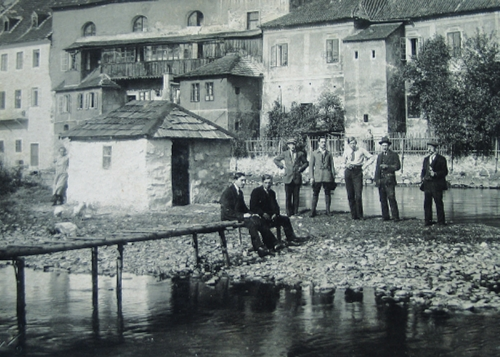
Josef Wolf - Second from left standing
Born on 26 April 1900 in Krumau, Sudetenland. And like his brother was a photographer too. At the begining of the Second World War he was a member of the Wehrmacht (German Army) and in autumn 1941 he was ordered to report to T4.
In T4 he was also employed as a photographer until he was posted with his brother, Fritz Konrad and Willi Wendland to Sobibor via Lublin in early March 1943. He supervised the sorting barracks, and in one of these he was killed during the prisoner revolt on 14 October 1943, by Boris Tsibulsky
ZANKER, Hans
Born on 8 September 1905, in Sachsen. He served in the T4 institutes of Pirna / Sonnenstein as a cook. He served at the death camps in Poland including, Belzec, Sobibor and Treblinka. Also served as a cook at the Jewish labour camp in Poniatowa. Posted to Trieste, Italy.
ZASPEL, Fritz
Born on 31 October 1907. He was employed in the T4 institute of Pirna/ Sonnenstein as a male nurse. He served in the Sobibor death camp. No further details known.
ZIERKE, Ernst Theodor Franz
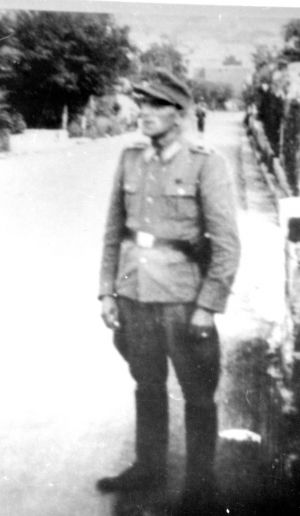
Ernst Zierke in Italy
Born on 6 May 1905 in Krampe, the son of a railroad worker. After he graduated from elementary school he worked as a forester, and in 1921 he was apprenticed to be a blacksmith. After passing the blacksmith apprenticeship exams he was employed in agriculture from 1925.
In 1934 he changed careers and became a nurse at a clinic at Neuruppin near Brandenburg and was summoned to the T4 Headquarters in Berlin in December 1939 and he served at the T4 institute at Grafeneck and Hadamar.
In the winter of 1941/42 he was drafted into the Organisation Todt for the care of the wounded in Russia. He returned to Germany and worked at a T4 institute at Eichberg, near Rudesheim. He was posted to Belzec death camp in June 1942 where he served until March 1943. At Belzec he served on the ramp.
In March 1943 he was transferred along with Robert Juhrs to the Jewish Labour at Dorohcza, which dug peat, until November 1943. Zierke was amongst the SS who escorted the Jewish Arbeitshaftlinge from Dorohucza to the neaby Jewish Labour camp at Trwniki, where all of them were shot, as part of Aktion Erntefest (Harvest Festival).
Zierke was sent to Sobibor death camp, to help with the closure of the camp, and he formed part of the cordon that watched over the final liquidation of the Jewish workers from Treblinka. He was then posted to Italy.
Zierke was acquitted at the Belzec Trial in Munich in 1964 and was released from custody during the Sobibor Trial in Hagen on health grounds. Zierke died on 23 May 1972.
REICHSBAHN PERSONNEL CONNECTED WITH THE DEATH CAMPS
BUCKSTEEG, Josef
He was born on March 18, 1888. As remembered by Georg Holzel, a Reichsbahn official. Bucksteeg was the station master at Sobibor. He came from the Kleve area,and was interrogated after the end of the Second World War.
CAMP CONSTRUCTION
MOSER, Bruno (Baurat)
An architect based in Cholm who hailed from Southern Germany, who helped with the camp construction, and who organised the supply of construction materials for the camp. Later on he transferred to the Technische Hauptamt in Krakau. He also was a member of a construction commission along with Rudolf Nauman, from the Waffen-SS Construction Department in Lublin, that inspected the Belzec death camp, before it became operational.
Sources
Publications
ARAD, Yitzhak, Belzec, Sobibor, Treblinka (Bloomington: Indiana University Press 1987)
BEM, Dr. Marek. Sobibor Extermination Camp 1942-1943 (Stichting Sobibor, Amsterdam 2015)
BERGER, Sara, Experten der Vernichtung das T4 -Reinhardt -Netzwerk in das Lagern Belzec, Sobibor, Treblinka (Hamburger Instituit fur Sozialforschung Hamburg 2013)
BIALOWITZ, Philip, A Promise At Sobibor (The University of Wisconsin Press
BLATT, Thomas (Toivi), Sobibor The Forgotten Revolt (H.E.P Issaquah 1988)
BLATT, Thomas (Toivi) , Sobibór: Zapomniane powstanie (Włodawa: Muzeum Pojezerza Łęczyńsko – Włodawskiego we Włodawie, 2010)
BÖHM, Dr Boris, Nationalsozialistische Euthanasiaverbrechen in Sachsen (Dresden Pirna: Kuratorium Gedenkstätte Sonnenstein 1996)
BÖHM, Dr Boris, Sonnenstein Heft 3 (Pirna: Kuratorium Gedenkstätte Sonnenstein 2001)
FREIBERG, Dov, To Survive Sobibor (Gefen Publishing House Jreusalem 2007)
GRABHER, Michael , Irmfired Eberl: "Euthanasie"-
HILBERG, Raul , Die Vernichtung der europäischen Juden, Band 2 (Frankfurt am Main: Fischer Taschenbuch Verlag, 1990
HOFFMANN, Dr Ute Hoffmann and SCHULZE, Dietmar ,(Gedenksatte Bernburg)
KLEE, Ernst Das Kulturlexikon zum Dritten Reich (Fischer S. Verlag GmbH 2007)
KLEE, Ernst , Was sie Taten – Was sie Wurden (Fischer Taschenbuch Verlag 1986)
KLEE, Ernst, DRESSEN, Willi, RIESS, Volker, The Good Old Days (Hamish Hamilton, London 1991)
NIEMANN, Johann, Fotos auf Sobibor, (Metropol, Berlin 2020)
NOVITCH, Miriam, Sobibor Martyrdom and Revolt (Holocaust Library New York 1980)
REITLINGER, Gerald, The Final Solution (Vallentine, Mitchell, London 1953)
SCHELVIS, Jules, Sobibor A History of a Nazi Death Camp (Berg, Oxford, New York 2007)
SERENY, Gitta, Into That Darkness – From Mercy Killing To Mass Murder (Pimlico, London 1974)
SZMAJZNER, Stanislaw, Hell in Sobibor – 1979 - unpublished copy
Websites
www. deathcamps.org
www. Holocaustresearchproject.org
www.Yad Vashem Central Database
Archives
Bundesarchiv Berlin
Gedenkstatte Sonnenstein
Ghetto Fighters House –Israel
Holocaust Historical Society
Landgericht Hamburg and Landgericht Dusseldorf
Schloss Hartheim
Michael Tregenza Archive
NARA Washington DC
Wiener Library London
Yad Vashem – Israel
Thanks to
ABDO, Alexander, Hessisches Hauptstatarchiv Wiesbaden, Germany
BLATT, Thomas
BOHM, Dr Boris Sonnenstein Memorial
BIEMANN, Georg
DE LESTRE, Howard
EIGELSBERGER, Peter Schloss Hartheim
HEIDEWEG, Hans
KUWALEK, Robert
RUTHERFORD, William (Billy)
SCHARNETZKY, Julius
SCHWANINGER, Florian Schloss Hartheim
TREGENZA, Michael, Articles on Lorenz Hackenholt, Richard Thomalla and in private correspondence with Chris Webb
WITTE, Peter
ZIEMER, Daniel - Sonnenstein Memorial
CUPPERS, Martin
© Holocaust Historical Society August 10, 2023

